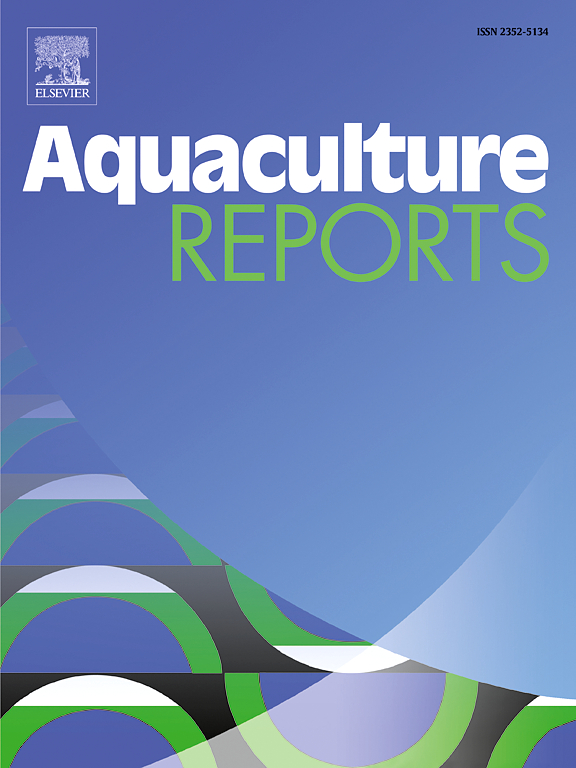利用黑藻(Hermetia illucens)幼虫对水产养殖废弃物与蔬菜副产品混合的生物转化:工艺参数和幼虫品质
IF 3.2
2区 农林科学
Q1 FISHERIES
引用次数: 0
摘要
不断增加的水产养殖产量在世界范围内产生了大量的生物废物,必须对其进行适当处理,以保持水产养殖的低足迹。本研究旨在评价黑虻(Hermetia illucens, BSF)幼虫对水产养殖废物流(RAS污泥、鱼屑和收获大藻废物)的生物转化效果及其生物量质量。本研究在模拟大规模环境的改良集装箱中进行,以啤酒废粮和白菜为基础,混合水产养殖废弃物配制饲粮,以达到尽可能高的夹杂率。观察到生物转化效率在20% %DM以上,物质减量一般在 55 %DM以上,同时产生富含蛋白质的幼虫生物量(>;35 %DM),必需氨基酸和脂肪酸。用某凤尾鱼加工厂的鱼残渣饲养的幼鱼的粗脂肪含量最高(29.0 ± 1.1 %DM),而大藻废饲料中添加的幼鱼的粗脂肪含量较低(14.7 ± 1.5 %DM)。有趣的是,我们观察到,添加水产养殖废弃物,即使是很小的夹杂量(湿基在15 %至25 %之间),也会降低幼虫体内饱和脂肪酸的浓度(尤其是月桂酸和戊酸)。综上所述,BSF幼虫能够生物转化各种水产养殖废物流,并且可以通过在其日粮中添加这些废物流来产生定制的幼虫生物量,从而能够生产具有特定性状的蛋白质成分,用于水产饲料。本文章由计算机程序翻译,如有差异,请以英文原文为准。
Bioconversion of aquaculture waste blended with vegetable by-products using Hermetia illucens larvae: Process parameters and larval quality
The constantly increasing aquaculture production generates high amounts of biowaste worldwide, which must be properly treated in order to keep aquaculture’s footprint low. This study aimed at evaluating the bioconversion of aquaculture waste streams (RAS sludge, fish trimmings, and harvest macroalgae waste) using black soldier fly (Hermetia illucens, BSF) larvae and the quality of the resulting larval biomass. The study was conducted in a modified shipping container simulating a large-scale setting and the diets were formulated using brewery spent grains and cabbage as base, mixing in aquaculture waste, aiming to treat the highest inclusion rate possible. A bioconversion efficiency of above 20 %DM and a material reduction generally above 55 %DM were observed, while generating a larval biomass that was rich in protein (> 35 %DM), essential amino acids and fatty acids. The larvae reared on fish trimmings (from an anchovy processing plant) had the highest crude fat content (29.0 ± 1.1 %DM) in relation to other treatments, while the macroalgae waste dietary inclusion generated larvae with low fat content (14.7 ± 1.5 %DM on average). Interestingly, it was observed that the addition of aquaculture wastes, even in small inclusion levels (between 15 % and 25 % on wet basis), reduced the concentration of saturated fatty acids in the larvae (especially lauric acid and pentadecanoic acid). It was concluded that BSF larvae are able to bioconvert varied aquaculture waste streams and it is possible to produce tailored larval biomass by adding such waste streams in their diets, enabling the production of a protein ingredient with specific traits to be used in aquafeeds.
求助全文
通过发布文献求助,成功后即可免费获取论文全文。
去求助
来源期刊

Aquaculture Reports
Agricultural and Biological Sciences-Animal Science and Zoology
CiteScore
5.90
自引率
8.10%
发文量
469
审稿时长
77 days
期刊介绍:
Aquaculture Reports will publish original research papers and reviews documenting outstanding science with a regional context and focus, answering the need for high quality information on novel species, systems and regions in emerging areas of aquaculture research and development, such as integrated multi-trophic aquaculture, urban aquaculture, ornamental, unfed aquaculture, offshore aquaculture and others. Papers having industry research as priority and encompassing product development research or current industry practice are encouraged.
 求助内容:
求助内容: 应助结果提醒方式:
应助结果提醒方式:


